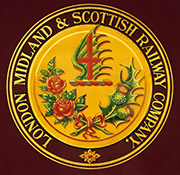

This site uses non-intrusive cookies to enable us to provide a better user experience for our visitors. No personal information is collected or stored from these cookies. The Society's policy is fully explained here. By continuing to use this site you are agreeing to the use of cookies.
We regret to report the passing of Graham Warburton a long standing member of the Society who was perhaps most famous for his work on LMS signalling published both in book form and in a long running series in LMS Journal.
Graham passed away, peacefully, on Saturday morning 24th February 2024 with his wife Pam at his side and with his family around him. He had been in very poor health for some time.
Our thoughts are with Pam and the rest of Graham's family at this sad time. A full obituary of Graham will be published on the site in due course.

A fascinating booklet has recently been uploaded to the site. Entitled "A Record of Large-Scale Organisation and Management" and written in 1946 near the end of the company's life it is best described as "The LMS by the LMS". Printed as a 9 inch by 6 inch booklet on cheap paper and unillustrated apart from some graphs and tabular data it is unclear who the intended audience was but it is basically a list of the company's achievements over its lifetime. Click here to access.
Welcome to the LMS Society web site, which is concerned with the London, Midland and Scottish Railway Company, which owned and operated a large part of the railway system in the United Kingdom from January 1923 until December 1947.
The London, Midland and Scottish Railway Company was formed as a result of the enactment of the 1921 Railways Act, which grouped 115 railways into 4 main companies; the grouping took effect from 1st January 1923, when the 'Big Four' companies came into existence; the other three being the London and North Eastern Railway, Southern Railway and Great Western Railway. There were three railways that remained jointly owned, the Somerset and Dorset Joint Railway (LMS and SR), the Midland and Great Northern Joint Railway (LMS and LNER), 50% of each was owned by the LMS and the Cheshire Lines Committee, of which the LMS' share was one-third, the LNER owning two thirds.
The company had interests from Bournemouth to Wick and from Great Yarmouth to Afon Wen and Swansea in Wales in Great Britain; of the grouped companies, the LMS was the only one having interests in England Wales, Scotland and Ireland, owning the Northern Counties Committee in Northern Ireland and the Dundalk, Newry and Greenore Railway in what was then the Irish Free State (now the Republic of Ireland)
These holdings made the LMS the largest of the grouped companies and indeed for a short time it was the largest joint stock company in the world.
The LMS developed, from 1927, a strong management structure guided by its President, Sir Josiah Stamp (later Lord Stamp) which, in turn, endowed a strong influence through its Officers and practices on the nationalised British Railways from 1st January 1948.
Since the formation of the LMS Society in 1963, its members have recorded the "what" of the LMS with numerous articles on its locomotives and rolling stock as well as its infrastructure; more recently we have tried to develop our work to link the "what" with the "why" (how and the Company was managed and by whom) to develop the picture of a living railway.
The pages of the site will show something of what we are about and what the LMS achieved in its 25 years of existence but a few words of introduction and explanation are in order here.
Society activities are not restricted to the years 1923 - 1947. They encompass the London, Midland and Scottish Railway, its precedents and antecedents and most of our members have interests in, and knowledge of, at least one pre-Grouping constituent company and/or the London, Midland Region and Scottish Region of the nationalised British Railways. We are proud of our record in the fields of research and publishing with over a thousand books and articles, having been written by our members. Also, the editors of three national railway historical magazines, the chief engineer of a main line preservation and train operating company, and prominent officers of several preserved railways belong to the LMS Society. Our efforts are not concerned, solely, with full size matters and the written word; the founders of the LMS Society were mainly dedicated railway modellers and the Society they established in 1963 was largely aimed at enabling modellers to portray the LMS more accurately and more easily. This aspect has not been forgotten and Society members are actively involved in helping firms both large and small develop kits as well as ready to run models of LMS prototypes. The Society also makes use of model railways, portraying the LMS, which appear at exhibitions to be used by the Society as a teaching aides to modellers and enthusiast interested in the LMS.
The Society has continually sought to help those who are seeking information about the LMS. We always welcome queries and will do our best either to answer them directly or to indicate other possible sources of information. In the first instance, such enquiries should be made to the Secretary, whose contact details will be found in the 'The LMS Society' page but we would ask correspondents to note certain caveats:
Once again, welcome to our web site. I hope you enjoy your visit and if you have any suggestions for its improvement, please contact us through the link.
Michael Byng
Chairman, LMS Society
Site contents Copyright © LMS Society, 2024

April 19th, 2024
Site contents Copyright © LMS Society, 2024